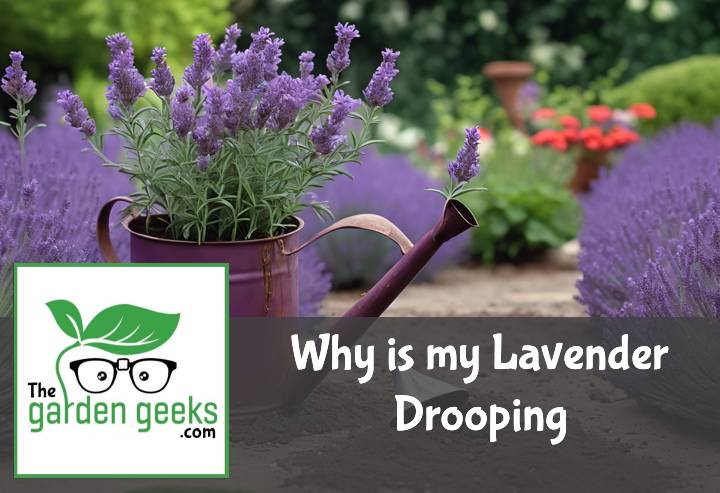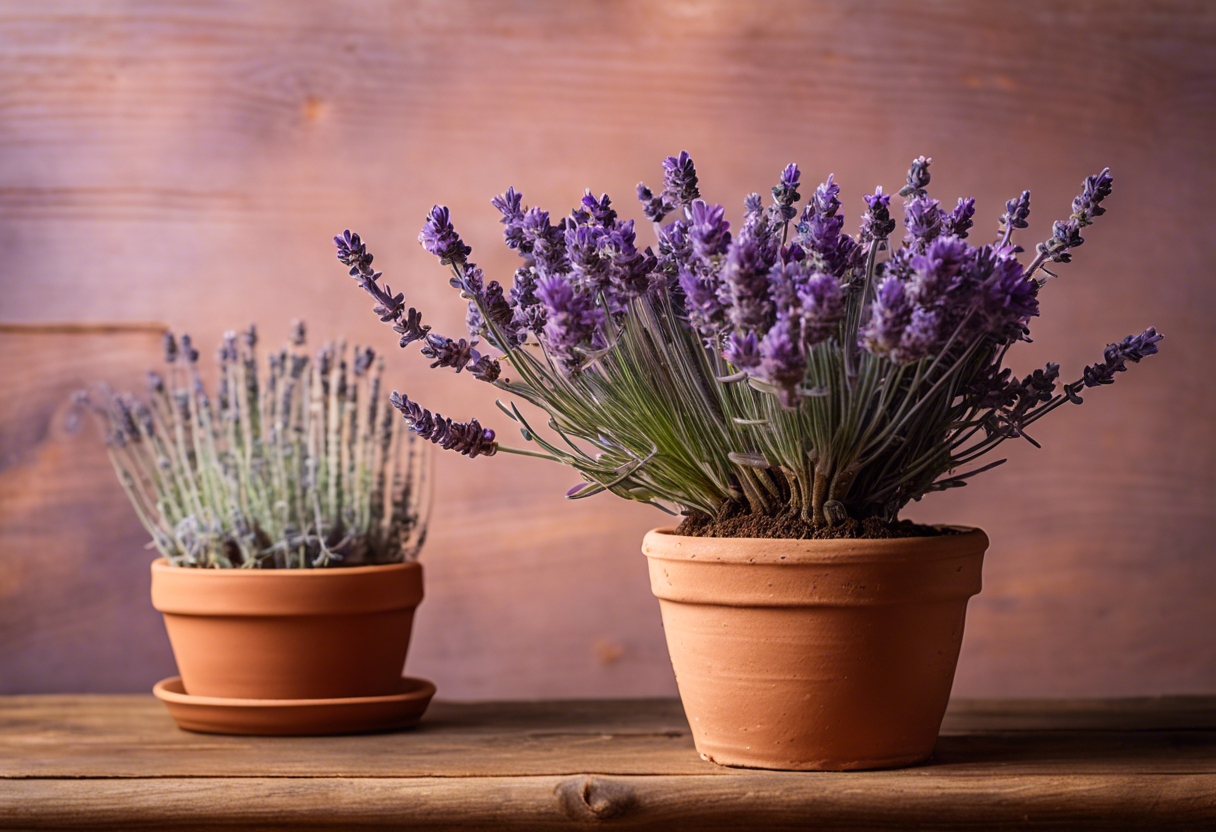Ever looked at your lavender plant and thought, Why is my Lavender Drooping? I know I have. It’s like it suddenly decided to do the limbo without telling you. You’re not alone in this, trust me.
In this post, we’ll dive into the possible reasons behind your lavender’s sudden interest in floor gazing and how to help it stand tall again. So buckle up and let’s get to solving this droopy dilemma together! “Keep reading about Why is my Lavender Drooping? (The Solution)”
Key Takeaways
- Lavender plants droop due to overwatering, poor drainage, or insufficient sunlight.
- Overwatering causes root rot which leads to wilting. Water only when the top soil is dry.
- Poor drainage can also cause root rot. Ensure your lavender is planted in well-draining soil and pots.
- Lavenders need full sun (at least 6 hours a day) to thrive. If indoors, place near a south-facing window.
- To fix drooping lavender, adjust watering practices, improve soil drainage, or increase light exposure.
What is Lavender?
Ah, lavender! It’s more than just a pretty face in the garden. This lavender plant is a perennial favorite among gardeners for its vibrant purple blooms, soothing scent, and versatile uses. From aromatherapy to culinary delights, lavender uses are as diverse as the types of lavender available. But here’s the catch – while it’s a relatively hardy plant, growing lavender requires specific conditions to truly thrive. So if you’re wondering ‘Why is my Lavender Drooping?‘, it might be due to not meeting these ideal conditions.
Description and Characteristics of Lavender
Lavenders are like nature’s own little perfume factories. Their signature lavender scent wafts through the air, making your garden smell like a slice of heaven. The plants themselves are quite charming too. They typically sport spiky purple flowers that give off their famous aroma. These beauties come in different sizes and shapes depending on the types of lavender plants, but most are compact and bushy.
The color though! Oh boy! That striking lavender color can make any dull corner come alive with vibrancy. And let’s not forget about those silvery-green leaves that add an extra layer of visual appeal.
Ideal Growing Conditions for Lavender
Now onto the nitty-gritty: how to keep your lavender happy and healthy. These plants love basking in full sun; they need at least 6 hours of sunlight daily (lavender sunlight needs). So if your plant is tucked away in a shady corner, it might start throwing tantrums (read: drooping).
As for soil, lavenders prefer well-drained soil with neutral to slightly alkaline pH (best soil for lavender). They don’t fancy ‘wet feet’, so avoid overwatering or planting them in areas prone to waterlogging.
Lastly, the temperature for growing lavender. These plants are Mediterranean natives, so they prefer milder climates. However, they can tolerate a bit of chill and heat too. Just remember – extreme temperatures can stress them out causing issues like…you guessed it…drooping!
Why is my Lavender Drooping?
So, you’re asking yourself, “Why is my Lavender Drooping?” Well, it could be due to a number of lavender care mistakes. Let’s dive into the common culprits: watering issues, sunlight exposure, soil conditions, and pests or diseases. Don’t worry though; we’ve got some drooping lavender solutions for you!
Overwatering or Underwatering
Ah, the classic watering conundrum! Both overwatering and underwatering can make your lavender plant droop faster than a teenager asked to do chores. If your lavender looks like it’s had too much to drink (think yellow leaves), you might be dealing with signs of overwatered lavender.
On the flip side, if your plant seems thirstier than a marathon runner and has dry, brittle leaves – that’s right – you’ve got an underwatered lavender on your hands. But don’t fret! Correcting watering issues in lavenders isn’t rocket science. It’s all about finding that Goldilocks zone – not too much, not too little.
Lack of Sunlight
Next up on our list of suspects is lack of sunlight. Just like us humans need our vitamin D, lavenders need their fair share of sunshine too! Insufficient light can cause your plant to droop like a sad sunflower at midnight.
If you notice pale leaves or slow growth, these are telltale signs that your lavender isn’t getting enough rays. So how do we fix this? Simple! Make sure your plant gets at least 6 hours of sunlight daily – that’s the basic lavender sunlight requirement.
Poor Soil Conditions
Now let’s talk dirt – literally! Poor soil conditions can lead to a drooping lavender faster than you can say “compost”. Lavenders prefer well-draining soil, so if your plant is sitting in soggy dirt, it’s going to droop like a wet noodle.
On the other hand, soil that’s too dry or nutrient-poor can also cause problems. The solution? Get yourself some good quality potting mix – that’s the ideal soil for lavenders.
Pests and Diseases
Last but not least, let’s talk about uninvited guests. Pests and diseases can cause your lavender to droop faster than a balloon with a slow leak. Common culprits include aphids, whiteflies, and fungal diseases.
If you notice discolored leaves or a generally sickly-looking plant, you might be dealing with pests affecting lavenders or diseases causing lavender wilting. But don’t panic! There are plenty of treatments available to help your plant bounce back.
How to Identify the Cause of Drooping Lavender?
If you’re asking yourself, “Why is my Lavender Drooping?“, don’t panic! It’s all about playing detective and spotting the signs. Let’s dive into the common causes.
Signs of Water-related Issues
When it comes to watering issues in lavenders, it’s a bit like Goldilocks’ porridge – not too much, not too little, but just right. Overwatered lavender symptoms can include yellow leaves and a droopy appearance. On the flip side, underwatered lavender signs might be wilting or crispy leaves.
Remember, your lavender isn’t a cactus nor a water lily. It likes its soil moist but well-drained. So if you notice any effects of improper watering on lavenders, adjust your watering routine accordingly.
Indications of Insufficient Light
Next up on our list of causes of drooping lavender is insufficient light. Your lavender plant loves basking in the sun like a cat on a window sill. If it doesn’t get enough light, it’ll start showing signs of discontent.
Look out for leggy growth or faded leaf color – these are classic signs of insufficient light in lavenders. Remember, these plants have their roots in sunny Mediterranean climates so they need plenty of rays!
Symptoms of Soil Problems
Soil problems can also cause your lavender to droop faster than an ice cream cone on a hot day. Lavenders prefer well-draining soil with neutral to slightly alkaline pH levels.
If your plant has yellowing leaves or stunted growth, these could be signs of poor soil conditions for lavenders. Don’t forget to check the pH level and drainage capacity before planting your lavender!
Evidence of Pest or Disease Infestation
Last but certainly not least on our list is pest or disease infestation. If your lavender is drooping, it might be playing host to some unwanted guests.
Look for signs like discolored leaves, spots, or visible pests. These are clear signs of pest infestation in lavenders. Similarly, wilting or dying branches could indicate a disease. Remember, prevention is better than cure when it comes to lavender pests and diseases!
Solutions to Fix Drooping Lavender
If you’re asking yourself, “Why is my Lavender Drooping?”, don’t fret! We’ve got some lavender plant solutions that’ll perk your plant right up. Let’s dive into these healthy lavender growth strategies.
Adjusting Watering Practices
Your lavender might be throwing a fit because it’s thirsty…or drowning. Overwatering and underwatering are both common causes of droopy lavenders. You see, lavenders are like Goldilocks – they need their water just right. So, what’s the secret? Well, aim for moist but not soggy soil. If your lavender is more wilted than a forgotten salad, it might be time to adjust those lavender watering needs.
Modifying Light Exposure
Lavenders love the sun – they’re total sunbathers! But too much of a good thing can cause them to droop. On the flip side, insufficient light can also lead to a sad-looking lavender. The key here is balance. Try adjusting the light exposure for lavenders by moving your plant to a spot with dappled sunlight or using sheer curtains to filter harsh rays.
Improving Soil Quality
Poor soil quality is another culprit behind drooping lavenders. These plants prefer well-draining soil that’s rich in organic matter. If your lavender looks more downcast than an emo teenager, it might be time to improve that soil health! Adding compost or organic matter can work wonders for enhancing soil health for lavenders.
Treating Pests and Diseases
Pests and diseases can turn your healthy lavender into a drooping mess faster than you can say “bug off!”. Common culprits include aphids, whiteflies, and fungal diseases like root rot. Don’t panic though – there are plenty of ways to treat these issues and prevent them from happening in the first place. So, keep an eye out for these common pests in lavenders and be ready to spring into action at the first sign of trouble.
Preventive Measures for Healthy Lavender Growth
Preventive measures are the backbone of maintaining healthy lavender. It’s like a health insurance policy for your plant, ensuring it stays fit and fabulous. Let’s dive into some key lavender care tips.
Proper Watering Techniques
Watering is a bit of an art form when it comes to lavenders. Too much or too little can lead to that dreaded droop. Overwatering in lavenders can cause root rot, while underwatering effects on lavenders can leave them parched and wilting.
It’s all about balance with these thirsty fellas. The trick is to keep the soil moist but not waterlogged. This is one of the most effective lavender growth prevention measures, helping you avoid the “why is my lavender drooping” conundrum.
Optimal Sunlight Exposure
Sunlight: it’s like the spinach to Popeye for your lavender plant. But just like Goldilocks, they need their sunlight exposure just right! Too much sun can scorch them, while too little leaves them languishing.
Optimal sunlight exposure is crucial for healthy lavender growth. It helps boost photosynthesis, leading to vibrant and vigorous plants. So remember folks, when it comes to sunlight, moderation is key!
Ideal Soil Conditions
The soil is where your lavender lays its roots (literally), so getting this right is paramount! Ideal soil conditions for lavenders include good drainage and a slightly alkaline pH level.
Poor drainage can lead to waterlogging and ultimately root rot – a surefire way to end up asking “why is my lavender drooping?“. On the other hand, an optimal pH level ensures nutrient availability, promoting robust lavender plant health.
Regular Pest and Disease Checks
Last but definitely not least on our list of preventive measures are regular pest and disease checks. These are like the routine doctor visits for your lavender plant.
Regular checks help identify any potential threats early, allowing you to nip them in the bud (pun intended!). From aphids to fungal diseases, catching these culprits early can save your lavender from a droopy fate. So keep those eyes peeled and stay vigilant!
To Wrap Up
So, we’ve dug deep into the soil of Why is my Lavender Drooping and unearthed some root causes. Like a detective on a garden-themed crime show, you’re now equipped to spot the signs of overwatering, under-watering, or poor drainage.
Remember folks, lavender plants are like that friend who loves their space – too much love (or water) can be smothering. Give them room to breathe and they’ll reward you with their calming scent and lovely blooms!





